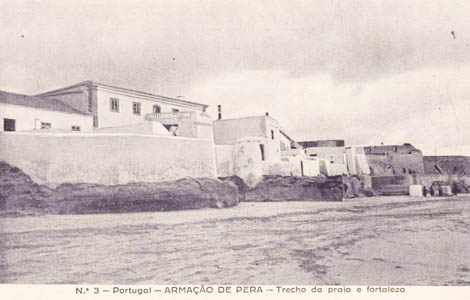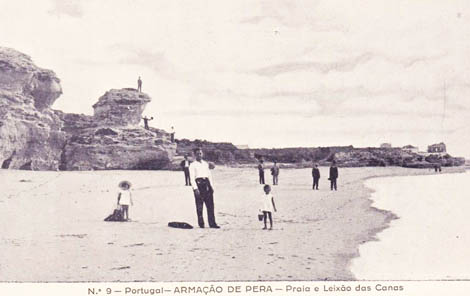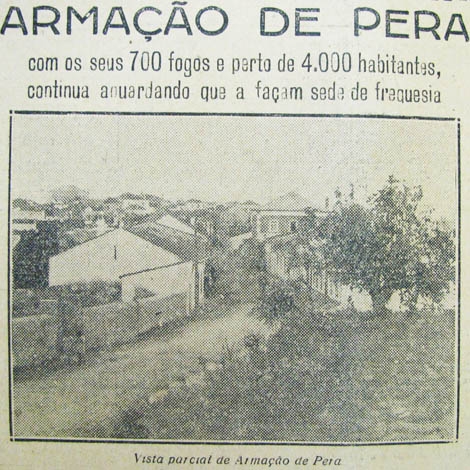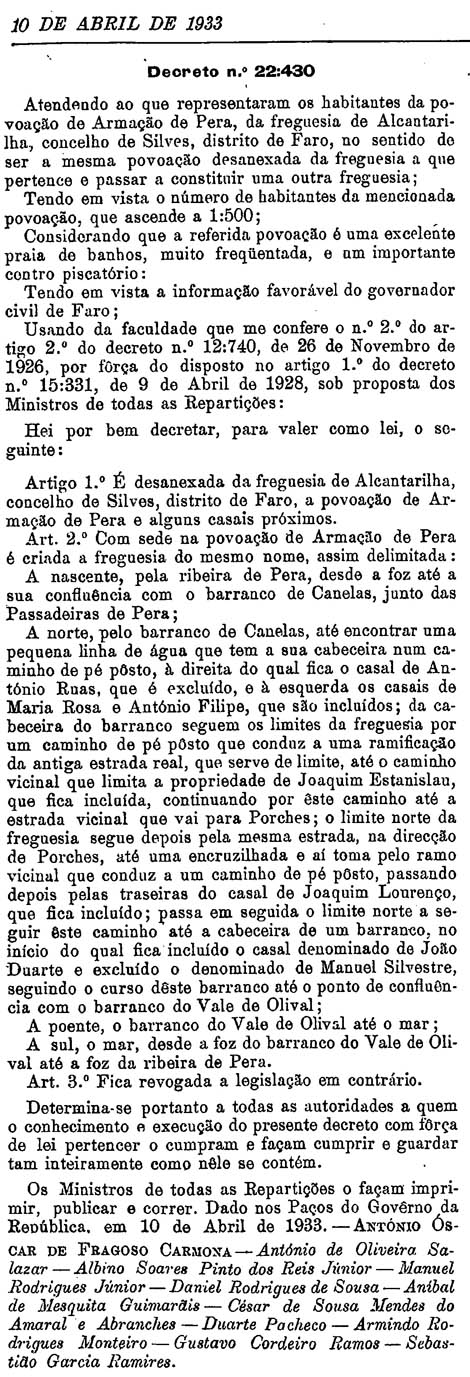 On April 10, 1933, the Armacenenses saw an old aspiration fulfilled: the Government Gazette published the Decree to elevate the village to the seat of a parish.
On April 10, 1933, the Armacenenses saw an old aspiration fulfilled: the Government Gazette published the Decree to elevate the village to the seat of a parish.
On the same day, another diploma elevated the town of Mira, in the municipality of Porto Mós, to town, naming it Mira de Aire.
In the national context, that day closed yet another peculiarity: it was the last day of the “Military Dictatorship”, given that on April 11 the 1933 Constitution entered into force, and with it the Estado Novo began.
Already in 1927 the Armacenenses had mobilized with a view to their autonomy and consequent separation from the parish of Alcantarilha.
Pedro Mascarenhas Júdice tells us of this, in the periodical “Folha de Alte”, in the edition of 15 September 1927: “Armação de Pêra has its own living conditions, regardless of its bathing beach conditions; it is one of the most important towns in the municipality of Silves, and is already thinking of becoming a parish”.
The village had a fishing company, fish canning factories, casino, doctor and post office. In addition, the beach was one of the most popular in the region, “mainly by the inhabitants of the municipality of Silves and Alentejo.”
In the following years, it was through Mário Lyster Franco, correspondent of the «Diário de Notícias», that the pretensions of the Armacenenses were repeatedly listed in that Lisbon daily.
 On February 14, 1930, at the invitation of the Armação Initiative Commission of Pêra, it was the village visited by several personalities, including José Martinho Simões, general director of Political and Civil Administration and general secretary of the Ministry of the Interior, accompanied by João Pereira Matos Cruz and José Martins Ribeiro, heads of the same department, who purposely moved from Lisbon.
On February 14, 1930, at the invitation of the Armação Initiative Commission of Pêra, it was the village visited by several personalities, including José Martinho Simões, general director of Political and Civil Administration and general secretary of the Ministry of the Interior, accompanied by João Pereira Matos Cruz and José Martins Ribeiro, heads of the same department, who purposely moved from Lisbon.
The objective was to find out in loco about the “justice that attends this place in the municipality of Silves, which wants to be made the seat of a parish”.
The reception and stay of guests was widely publicized in the edition of Diário de Notícias, on 20 February: “Lots of people gathered at the entrance to the village. As soon as the cars were seen, many rockets were burned, showing the satisfaction of all the inhabitants in the smallest details. Satisfaction for the honor of the visit and for the hope that soon Armação de Pêra would see his greatest and oldest aspiration fulfilled – to be a parish”.
The delegation then toured the streets of the village in detail. This one was decked out, hanging silk bedspreads from some buildings. As the guests passed by, “there were thunderous applauses and many “cheers”.
And so, amidst a veritable rain of flowers, which were thrown on the windows from the windows, they traveled through part of Armação de Pêra, deserving particular attention to the so-called Bairro do Casino and the primary school building.

”After a short walk along the beach, a banquet2 took place at the home of teacher Maria do Céu Graça, which ended with several speeches. The last speaker was Dr. Martinho Simões, who said “he had verified all the justice that attended Armação de Pêra's claim, a claim that would have in him a staunch defender, and which would certainly become a fact when the new Administrative Code. (…) To the words of mr. dr. Martinho Simões was followed by a resounding round of applause."
At the end of the banquet, the visitors went to their cars and, at the “time of departure, many 'lives' were raised for the future parish of Armação de Pêra”.
The invitation of the Armação de Pêra Initiative Commission to the entities and the support of the people from Armacao during the visit to the village proved to be a resounding success.
About a month later, on March 29, 1930, Lyster Franco recalled in the Diário de Notícias Armação's pretensions: “it gives pleasure to highlight his ardent desires, to shout again to the public authorities for the justice that assists him, to which is why it enjoys a land that, in this century of immeasurable ambitions, wants to be the seat of a parish and nothing else!…”.
Justifying then: “With more than 700 dwellings, a population of approximately 4000 inhabitants, spread over countless streets, in a pile of houses that leaves almost all the rural parishes in our province out of sight, the picturesque village of the municipality of Silves, you are undeniably right in what you are asking for”.
After considering the territorial limits of the future parish, which, in his opinion, was “naturally demarcated, within those two square kilometres, which border the sea, the Calvário bridge, the Ribeira de Pera and the Barranco do Vale do Olival” , whereby “no one would raise obstacles, no one would raise a voice that sounded discordant”, Mário Lyster Franco concluded on the pretension: “a wish that is a true aspiration, which is more than an aspiration, it is a sacred ideal!…”.

In the following months, new news systematically fought for the rise of Armação de Pêra to the seat of the parish. Finally, on April 10, 1933, and long before the publication of the new Administrative Code, Decree No. 22:430 consigned the wish of the Armacenenses:
"Given what the inhabitants of the village of Armação de Pera, in the parish of Alcantarilha, municipality of Silves, district of Faro, in the sense of being the same village detached from the parish to which it belongs and becoming another parish; Considering the number of inhabitants of that village, which amounts to 1:500;
Considering that the aforementioned village is an excellent bathing beach, very frequented, and an important fishing centre:
In view of the favorable information from the civil governor of Faro;
(…) I would like to decree, to be effective as law, the following:
Article 1. It is detached from the parish of Alcantarilha, municipality of Silves, district of Faro, the village of Armação de Pera and some nearby couples.
Article 2 With headquarters in the town of Armação de Pera, the parish of the same name is created, thus delimited (...).
Article 3 Legislation to the contrary is hereby revoked. (...)".
The event was received in Armação de Pêra with rejoicing, as reported by Diário de Notícias, in the April 13 edition, “Armação de Pêra, 11 – Today, at 10:XNUMX am, news came about the creation of the parish, headquartered in this location, which provoked great rejoicing, as some rocket spinners went up in the air.”
Identical party took place in Mira de Aire. But if the process for the creation of the parish of Armação had been slow, its materialization would not be easier. If Mário Lyster Franco had predicted that its territorial limits were naturally demarcated, the Câmara de Lagoa did not have the same understanding.
The latter would soon come to protest, claiming that “a large number of rustic buildings and some couples from the parish of Porches” had been attributed to the new parish, in that municipality, and not even the visit of the civil governor, in September 1933, with a view to resolving the conflict. , calmed the tempers.
On the following May 24, two commissions were appointed, one by the Chamber of Silves, the other by Lagoa, but in 1935 the dispute still dragged on. Despite this setback, the Armacenenses had finally realized their dream. His effort and parochialism, to which the support of Dr. Mário Lyster Franco/Diário de Notícias was not unconnected, had had an effect and Armação de Pêra was now the seat of the parish.
Eighty years later, armacenences may be proud of the determination of their ancestors, but it will be with regret that they tolerate the Parish Council installations, on the first floor of an apartment, instead of occupying a decent space, or even a building of their own.

Author Aurélio Nuno Cabrita is an environmental engineer and researcher of local and regional history


















Comments